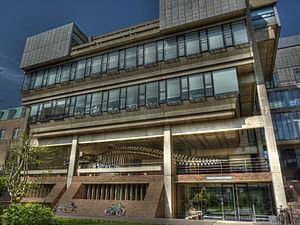Cambridge University Museum of Zoology facts for kids

Giant Finback whale at the Museum of Zoology
|
|
| Location | Museum of Zoology, Downing Street, Cambridge. CB2 3EJ |
|---|---|
| Type | University Museum |
| Accreditation | Arts Council England accredited |
| Collections | Fossils, Vertebrates, Birds, Insects, Molluscs, Invertebrates |
| Visitors | 103,604 (2022) |
| Owner | University of Cambridge |
| University of Cambridge Museums | |
The University Museum of Zoology is a fantastic place to explore the animal kingdom! It's part of the famous University of Cambridge and helps scientists study animals. Everyone is welcome to visit, and it's free to get in!
You can find this amazing museum in the David Attenborough Building in central Cambridge, England. This building also hosts the Cambridge Conservation Initiative, a group working to protect biodiversity.
The museum has a huge collection of important animal specimens. In 1998, these collections were recognized for their outstanding historical and global importance.
The museum reopened on June 23, 2018, after a big makeover. This project helped create exciting new displays. It also improved how the museum cares for its valuable collections. Plus, it expanded learning programs for more people.
The University Museum of Zoology is one of eight museums in the University of Cambridge Museums group.
Discovering the Museum's Past
Many of the museum's items come from big expeditions in the 1800s. These trips helped scientists record animals from all over the world for the first time. The oldest exhibits are from the Harwood anatomical collection, bought in 1814.
The museum later added more collections. These included birds from William Swainson. Animals from the Cambridge Philosophical Society were also added. Even Charles Darwin himself contributed to these collections!
The museum moved into its current building between 1968 and 1970. This building was specially designed for the collections. Today, five separate storage areas keep the specimens safe.
Amazing Animal Collections
Many collections were gathered during the 1800s. This was a very important time for developing modern biology. Most items were collected between 1865 and 1915. They came from private collections and scientific expeditions. Cambridge was a key place for new ideas in biology. Many people linked to the museum were central to big scientific discussions.
You can see collections and letters from many famous collectors. These include:
- F.M. Balfour, a Professor of Zoology
- George Robert Crotch, an expert on insects
- Charles Darwin, the famous Naturalist
- Sir Clive Forster-Cooper, a past director of the museum
- John Henry Gurney Sr., a banker and bird enthusiast
- James Hepburn, a bird expert
- Reverend Leonard Jenyns, who was almost the naturalist for the voyage of HMS Beagle
- Robert MacAndrew, an amateur naturalist and shell collector
- Alfred Newton, a zoologist and bird expert
- Hugh Strickland, another bird expert
- William Swainson, an ornithologist
- Alfred Russel Wallace, who helped develop the idea of natural selection
- Henry Woodward, a geologist
Before the museum's big makeover, a huge 21.3 meter (70 foot) finback whale skeleton greeted visitors. People called it Bobby! It was taken apart and stored during the renovation. Now, this giant skeleton is back in the new entrance hall. It was carefully cleaned before being put back together.
The museum also has skeletons and preserved skins of many extinct animals. Many fish specimens are kept in special liquid. Some of these were even collected by Darwin himself! He found them during the voyage of HMS Beagle from 1831 to 1836.
The bird collection includes skins, eggs, and bones. You can see bones from extinct birds like the dodo from Mauritius. There are also remains of the Rodrigues solitaire from Rodrigues. The insect collection has specimens Darwin collected around Cambridge. Collections of molluscs, corals, and other sea creatures show the amazing variety of ocean life.
-
From left to right: Bornean orangutan, female and male western gorilla, chimpanzee, and human skeletons.
See also
 In Spanish: Museo de Zoología de la Universidad de Cambridge para niños
In Spanish: Museo de Zoología de la Universidad de Cambridge para niños
- Natural history museums


